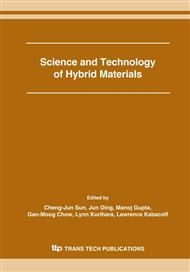p.87
p.91
p.95
p.99
p.103
p.107
p.111
p.115
p.119
Structure-Property Relations in xCuO-(1-x)As2O3-0.7B2O3 (0.01≤x≤0.05) Glasses by Magnetic Susceptibility Measurements, IR and EPR Spectroscopy
Abstract:
Studies on xCuO-(1-x)As2O3-0.7B2O3(0.01≤x≤0.05) (G1-G5: x = 0.01, 0.02, 0.03, 0.04, 0.05) glasses were done using varieties of structure sensitive techniques. The powder X-ray diffraction (XRD) studies show the formation of glasses in the composition. The IR spectral results show the presence of Cu-O bond, planar [BO3/2] and [BO3 -n](n=1, 2, 3) units and tetrahedral {BO4/2]- units. The magnetic susceptibility results show Curie-Weiss behaviour in the range 4.2-400 K. The calculated values of the exchange integral from the Weiss constant obtained form the linear fit of the Curie-Weiss law are found to be in the range 5.22-29.50 meV. From the trend of the gmatrices of gơ>g⊥>ge (ge =2.0023) obtained from electron paramagnetic resonance (EPR) lineshapes simulation we conclude that the paramagnetic site in these glasses is Cu2+(3d9) which is in a tetragonally elongated octahedron [O1/2-CuO4/2-O1/2] exhibiting Jahn-Teller distortion having D4h symmetry with orbital singlet 3dx2-y2 (2B1g) as the ground state.
Info:
Periodical:
Pages:
103-106
Citation:
Online since:
April 2006
Authors:
Keywords:
Price:
Сopyright:
© 2006 Trans Tech Publications Ltd. All Rights Reserved
Share:
Citation:


